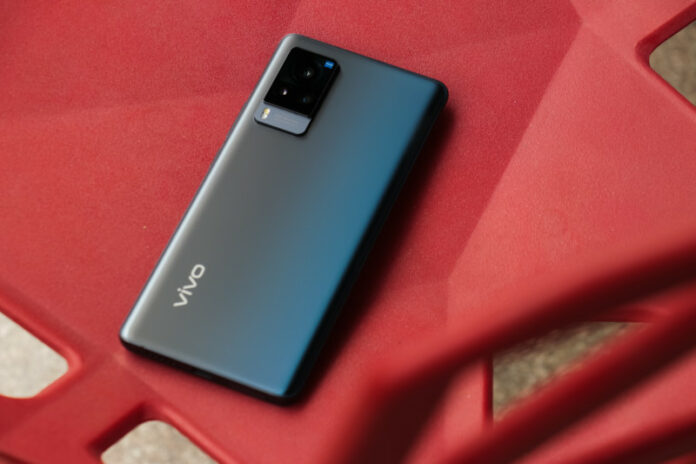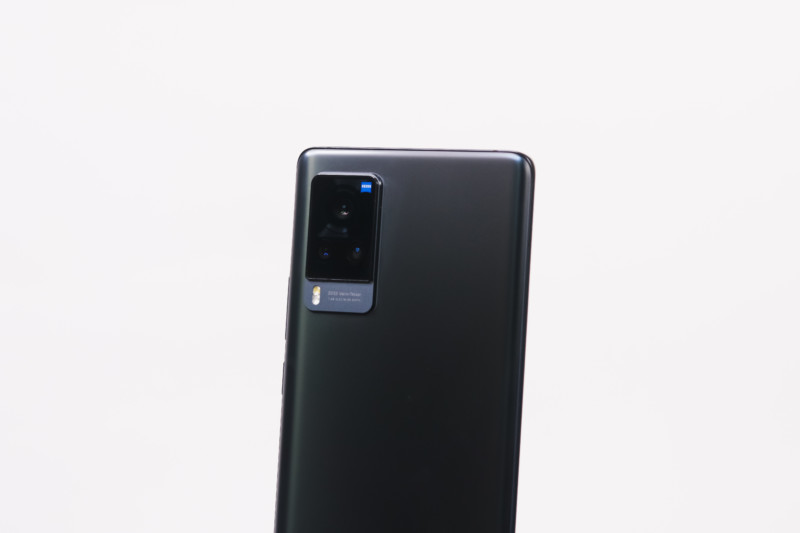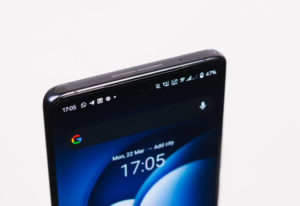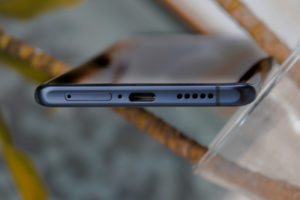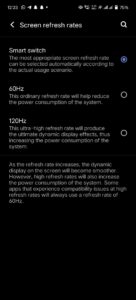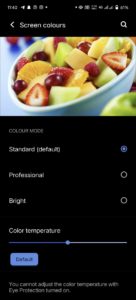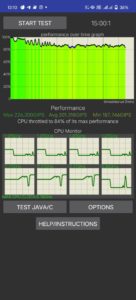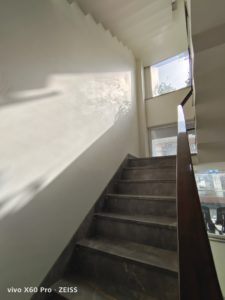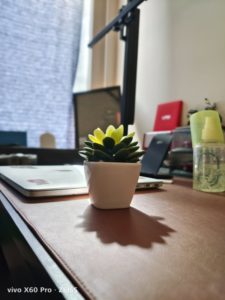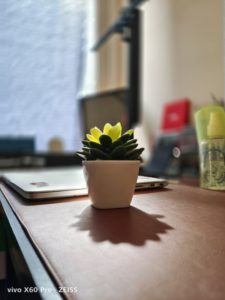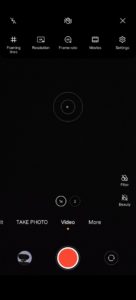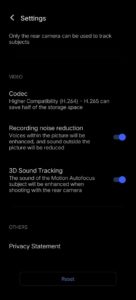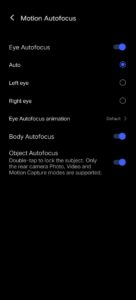The Vivo X60 series is the third addition to the Vivo’s X-series lineup which includes three devices;Vivo X60, X60 Pro and X60 Pro+. The first device which was introduced in the X-series was X21 which was the first smartphone to feature an in-display fingerprint scanner in India, then came the X50 Pro which featured a gimbal camera module which showcased the strides Vivo has made on the optics front. They’ve been working on this gimbal technology and now they have come up with a much improved devices second generation micro-gimbal tech. So, this is our review of the Vivo X60 Pro after using it extensively for over the past 10 days.
Here is the quick unboxing of the Vivo X60 Pro:
https://www.instagram.com/p/CM1akCsH6Gi/?igshid=1ivssedfbaop9
Before heading towards review here is a look at the specifications of the device:
| Brand | Vivo |
| Model | X60 Pro |
| Price in India | ₹49,900 |
| Release date | 22nd March 2021 |
| Launched in India | Yes |
| Form factor | Touchscreen |
| Dimensions (mm) | 158.58 x 73.24 x 7.59 |
| Weight (g) | 177.00 |
| Battery capacity (mAh) | 4200 |
| Fast charging | Proprietary |
| Colours | Midnight Black, Shimmer Blue |
| Screen size (inches) | 6.56 |
| Touchscreen | Yes |
| Resolution | 1080×2376 pixels |
| Protection type | Gorilla Glass |
| Aspect ratio | 19.8:9 |
| Processor | octa-core |
| Processor make | Qualcomm Snapdragon 870 |
| RAM | 12GB |
| Internal storage | 256GB |
| Rear camera | 48-megapixel (f/1.48) + 13-megapixel (f/2.2) + 13-megapixel (f/2.46) |
| No. of Rear Cameras | 3 |
| Rear autofocus | Yes |
| Rear flash | Yes |
| Front camera | 32-megapixel (f/2.45) |
| No. of Front Cameras | 1 |
| Operating system | Android 11 |
| Skin | Funtouch OS 11.1 |
| Wi-Fi | Yes |
| GPS | Yes |
| Bluetooth | Yes, v 5.10 |
| NFC | Yes |
| USB Type-C | Yes |
| Number of SIMs | 2 |
| SIM 1 | |
| SIM Type | Nano-SIM |
| GSM/CDMA | GSM |
| 3G | Yes |
| 4G/ LTE | Yes |
| 5G | Yes |
| Supports 4G in India (Band 40) | Yes |
| SIM 2 | |
| SIM Type | Nano-SIM |
| GSM/CDMA | GSM |
| 3G | Yes |
| 4G/ LTE | Yes |
| Supports 4G in India (Band 40) | Yes |
| Face unlock | Yes |
| In-Display Fingerprint Sensor | Yes |
| Compass/ Magnetometer | Yes |
| Proximity sensor | Yes |
| Accelerometer | Yes |
| Ambient light sensor | Yes |
| Gyroscope | Yes |
DESIGN & DISPLAY
The Vivo X60 Pro possesses a better in-hand feel when distinguished with X50 Pro, where the weight has been reduced from 181 grams to 177 grams (Midnight black) and thickness has been reduced to 8.04mm to 7.59mm which makes it more lightweight and slim. It has the same glass sandwich design which follows this generation as well. Earlier, Vivo X50 Pro surfaced with a satin-soft finish on the frosted glass back and now in the Vivo X60 Pro boasts an AG (Anti-Glare) Glass with the same satin finish which doesn’t surface fingerprints and smudges easily and delivers more matte effect than the previous generation. The frosted panel aids in gripping the device without any accidental slips. The aluminium frame looks more prominent with the curved display which is gentle and it’s flattened from top and bottom. Still, we’ll recommend using it with a case for accidental damages on falls. The rear glass is protected with Corning Gorilla Glass 6.
At the top of the edge, it has a mic and an inscription- ‘PROFESSIONAL PHOTOGRAPHY’ and on the bottom of the edge, there is a USB Type C Port with a speaker grille on its right and a SIM Tray slot on its left next to the noise cancellation mic. The right side boasts a power button and volume rocker which is less tactile than the Vivo X50 Pro and the power button has a textured finish which differentiates it from the volume rocker (like you saw on our review of Vivo V20 Pro) whereas the left side is bare. The Dual Sim tray slot doesn’t support any sort of expandable memory.
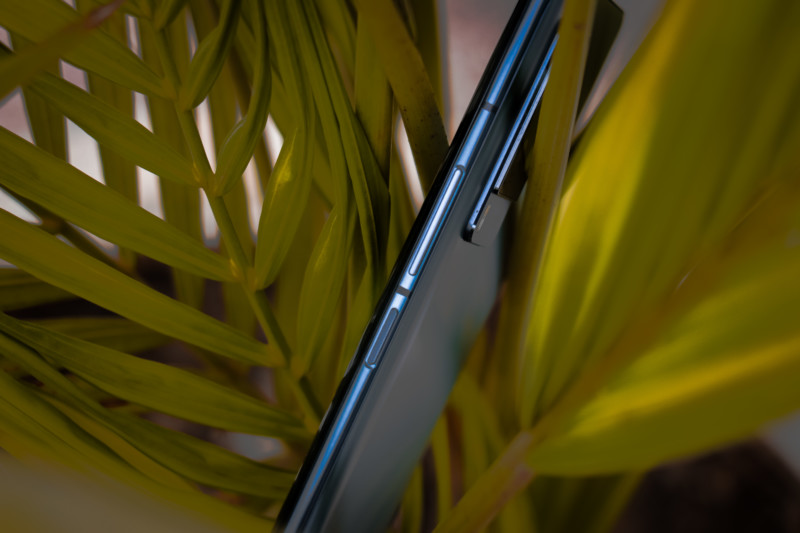
It boasts a camera bump that combines in the footprint of the device. The camera module houses a triple camera setup for which Vivo has co-engineered with ZEISS optics using Vario-Tessar lenses to offer clarity that is offered on high-end cameras. The device comes in two colours, Midnight Black(which weighs 177 grams) and Shimmer Blue (which weighs 179 grams). For our review, we are rocking the Midnight Black colour of this device.
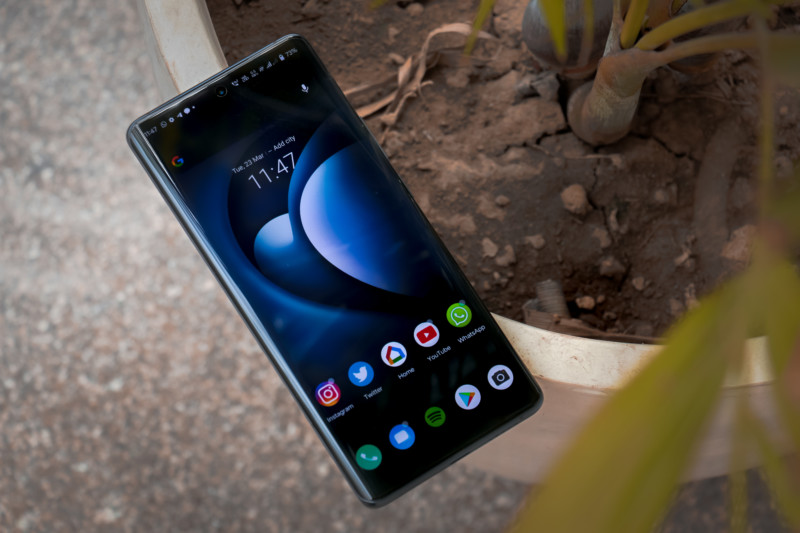
This 6.56 inch Full HD Amoled display has a peak brightness of up to 1300 nits where the screen to body ratio is 92.7%. The punch hole camera is now situated in the middle instead of the left corner. The bezels have been shrunk down to 1.75mm narrow, 2.76mm top and 1.66mm side bezels. It also supports up to 120hz refresh rate, you can alternately switch between 60hz and 120hz or can switch to smart switch mode that smartly switches between in both the profiles. Colours pop out in the ‘Standard’ mode which is the default colour profile. Apart from that, other modes are ‘Professional’ and ‘Bright’. On to the front, it has a protection of Schott Xensation UP for drops and scratches.
Thanks to HDR10+ certification, binge-watching especially looks crisp while the colours pop when you’re watching any OTT content on it. It comes with Widevine L1 which makes it eligible to stream HD videos on Amazon Prime, Netflix and other OTT platforms. The screen also houses an in-display fingerprint scanner which is quicker than the previous generation.
PERFORMANCE
The major aspect in which camera capable smartphones usually suffer is gaming. When Vivo X50 Pro was announced with 765G, people were concerned about the longevity of the device because of its mid-range processor. With Vivo X60 Pro, those concerns have been shunned. The Vivo X60 Pro is powered by the latest Qualcomm Snapdragon 870 which is a flagship series SOC powering on board with the support of 5G networking.
This is a 7nm based processor which offers a clock speed of up to 3.2 GHz. It comes in only one variant with 12GB of RAM and 256GB of UFS 3.1 Storage. It also has a virtual 3GB RAM which can store your unused apps which allocate 3GB from Internal Storage and use it as Virtual RAM. The graphic duties are handled by the Adreno 580 GPU. Even with the phone’s performance maxed out, the phone sailed through everyday tasks with ease. There were no stuttering or performance hiccups in Multitasking, Gaming and OTT streaming.
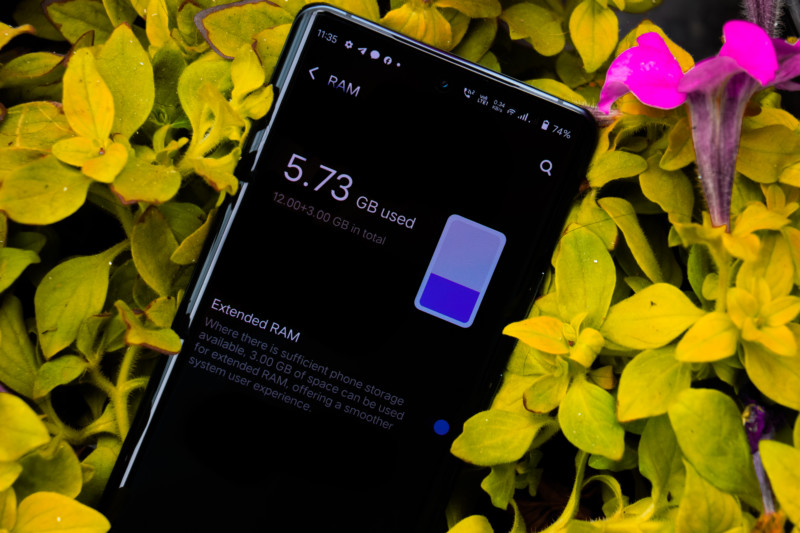
The phone handled benchmarks, which is to say that it beats most of the other smartphones in the market. We ran Antutu Benchmark where it scored 633253 beating Oppo Find X2 Pro and Samsung S21 5G (2100) easily. In the Geekbench test, it scored 946 beating Samsung S21 5G and Xiaomi Mi 10T Pro. In the CPU Throttling Test, the CPU throttled to 84% of its max performance.
Let’s move towards gaming performance, we played Genshin Impact, it managed to run it pretty well with no lags and frame drops. The device got a little warm on prolonged gaming sessions. We also played games like Asphalt 9, Call of Duty and Project Car Go and it managed to play them very smoothly without getting heated up. But, even when the device is getting warm, there were no performance hiccups that interrupted our gaming session.
CAMERA

The most diversifying aspect of this device is its cameras, Vivo co-engineered with ZEISS optics to create these Vario-Tessar lenses to offer you a quality that can be delivered by high-end cameras. Vivo has used a customised version of the Sony IMX 598 sensor for the primary camera with a large aperture of F/1.48 which levels up your low-light photography game. It sports a second-generation super stable micro head where it shifts the lens along two-axis using electromagnetic induction as you were familiar with X50 Pro. This VIS (Virtual Image Stabilization) 5-Axis stabilization is five times better than the standard OIS that most smartphones have. In the X50 Pro, there was a glitch that usually happened while recording videos in anti-shake mode which is now fixed in X60 Pro.
The photos captured from the primary sensor had the exposure well maintained and colours looked richer and saturated with a good amount of details on highlights and shadows in Indoor situations. In Vivo X50 Pro, there is a slight whitening in the background which isn’t able to clear up. In X60 Pro, the contrast of light and dark makes it even excels in retaining the details in the background.
In outdoor situations, it’s capable of controlling ghosting and glare; the aberration of the camera has been improved where the light refraction and diffraction is eliminated. Due to this, the monument is well lit and sun flare isn’t affecting the exposure at all. We’ve compared it with iPhone 12 on a scenario where the iPhone 12 fails to maintain the exposure of the sun and making the whole frame almost looks like a sunset whereas X60 Pro is able to maintain the highlights and shadows.
In the low light scenario, This device has got a huge jump off from its previous iteration and even with the devices which are close to its competition. The smartphone captures the details and maintains a good brightness very well. But when you zoom into 3-4x and click a picture in low light, the details usually blow out.
It has various shooting modes like 48MP, Panorama, Live Photo, Slow-Mo, Time Lapse, Pro, AR stickers, Supermoon, Doc, Astro, Pro Sports and Long Exposure. It has some long exposure modes as well which includes Flow of traffic, Night Graffiti, Waterfalls, Mysterious, Fireworks and Star Trails.
The secondary camera is a 13MP Ultra-wide angle lens which helps to capture a 120° field of view with an aperture value of F/2.46. The photo samples from an Ultra-wide angle almost looks familiar to the primary sensor but there is a difference in the colours in the background. Not noticeable, but it’s there. In well-lit scenarios, it’s hard to tell the difference between both lenses. Colours slightly shift when you change the angle which stands for the lack of inconsistency. If Vivo can fix this up with an update, Its camera will be undefeatable at this price bracket. This Ultrawide lens also doubles up as a Macro Camera which can be helpful in Macro photography where it can go close to an object up to 2.5cm.
The third sensor is a 13MP Professional portrait lens which has a depth of equivalent 50mm focal length with an aperture value of F/2.2. This lens can also be doubled as a Zoom lens in which you can zoom up to 2x optically and 20x digitally. You can rely on this zoom lens pretty well. The details remain the same as the primary lens till 5x zoom and afterwards on 10x zoom, the photo starts retaining grains.
The ZEISS Biotar Style works under the human scene separation processing technology where the background and the subject are processed separately which gives an awesome output. This mode makes the blurred background look like a vortex blur effect. Unlike, it only works on Human subjects.
It has really good video recording capabilities, it can shoot up to 4k 60fps thanks to the advantage of Gimbal Stabilisation, 4k 60 FPS seems more stable than 1080p 60 FPS where it offers two modes of stabilisation- Standard Stabilisation and Super Anti-Shake Stabilization. Both of these stabilisation options offer good stabilization to the footage where it also crops the footage to make it smoother. It offers more video options like Reduce Noise Reduction and 3D SoundTracking which improves the audio which is been recorded while shooting videos. It comes with a motion autofocus feature that can continuously focus on your eye whether it is left or right, body and object which is only available in Mirrorless and DSLR cameras.
For selfies, it boasts a 32 MP shooter on the rear with an aperture of f/2.45. Photos captured from the rear holds plenty of detail with a wide dynamic range, keeping the person’s face well lit even with a bright background. The front camera can even shoot up to 1080p 60FPS with a good amount of details and sharp focus.
SOFTWARE & BATTERY
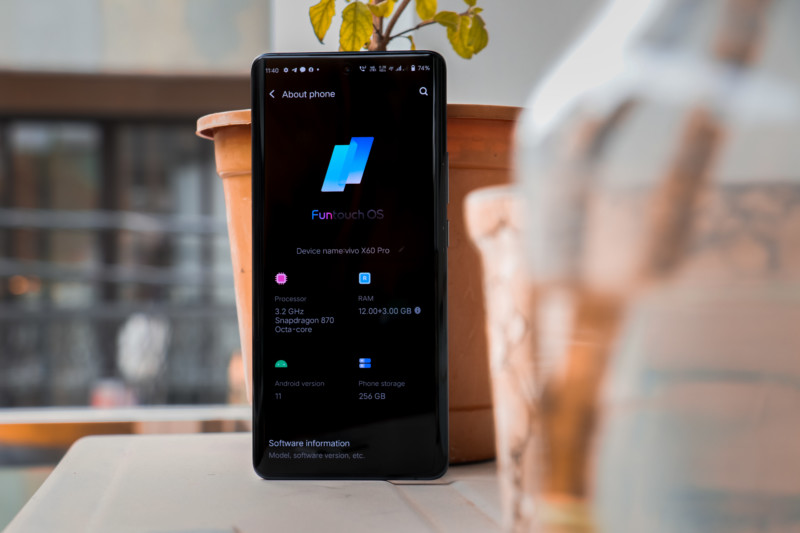
In terms of software experience, it ships with Funtouch OS 11.1 Global which is based on Android 11. On 17th March, we received an update: 1.75.20, which optimised the stability of the system and cameras. In our Vivo V20 Pro, we praised it for its almost stock-like software experience, Vivo X60 Pro continues the legacy of software. The Funtouch OS 11.1 software stacks feel like Stock Android which offers some customizations as well. The Funtouch OS is improving day-by-day. Just like other Vivo devices, it ships with those Vivo Goodies on the top.

In our review of Vivo X50 and Vivo V20 Pro, we mentioned that the global search can’t be disabled on the home screen which is now fixed by Vivo. Visit launcher settings – slide down to the home screen and switch it to the Notification centre. Some bloatware still cannot be removed from the device but that won’t create any hindrance to the user experience of the software like Xiaomi and Poco does by pushing inappropriate ads.
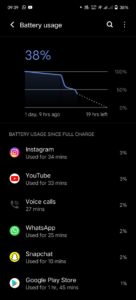
The Vivo X60 Pro packs in a 4200mAh battery and it also bundles a 33Watt Fast Charger in the box. The supplied charger can juice up the device from 0-100 in 80 minutes though there is no wireless charging enabled for this device which makes it behind its competitors. In our case, the Screen-on-Time was 6-7 hours which includes music playback from Spotify on a Bluetooth connected device continuously, watching videos on Youtube for 30 minutes, using social media platforms, voice calls and playing games with moderate camera usage where refresh rate was on 120hz. If you are someone who often uses your device, it can last up to a day or so very easily.
THE UNBIASED VERDICT
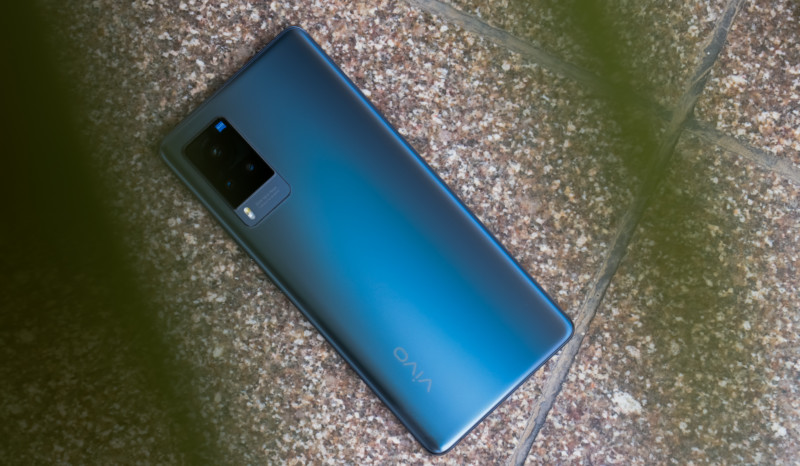
The Vivo X60 Pro comes in two colours- Shimmer Blue and Midnight Black with only one configuration,12GB RAM and 256GB ROM priced at Rs.49,990 with some extra beneficial offers like X League Premium Membership which has a 24*7 Exclusive Calling Line, 1 year extended warranty and complimentary 3 months Amazon Prime Membership.
If you’re someone who is looking for a smartphone with an impeccable design, curved AMOLED display with vibrant and punchy colours, flagship SoC and most importantly an unbeatable set of cameras, in simpler words an all-rounder smartphone then the Vivo X60 Pro is the device for you. With the price of the Vivo X60 Pro touching the 50,000 INR mark, it ends up directly competing with the OnePlus 9 5G, Asus ROG Phone 5 both of which offer Qualcomm’s Snapdragon 888 but with lesser RAM and ROM – 8GB and 128GB RAM. Hence, Vivo offers more for less with its 12GB RAM and 256GB ROM on the X60 Pro.
So if you were considering Samsung Galaxy S20 FE, OnePlus 8T, Xiaomi Mi 10 5G or even the OnePlus 9G, ASUS ROG Phone 5 then the Vivo X60 Pro offers more than any of these devices. Vivo has nailed this segment by implementing SD870 on board. In real-life scenarios, both these processors don’t have a huge difference in day-to-day usage and with the added RAM and ROM that slight difference in performance has also been taken care of.
Disclaimer: We tested the Vivo X60 Pro as our primary device on the Airtel and JIO 4G VoLTE networks for a period of 10 days. All our reviews are unbiased and are published without the brand getting to read them before you guys. We don’t change our reviews on pressure from brands and that’s the reason we are not sent review units from companies like Samsung, OnePlus, and a few more.
